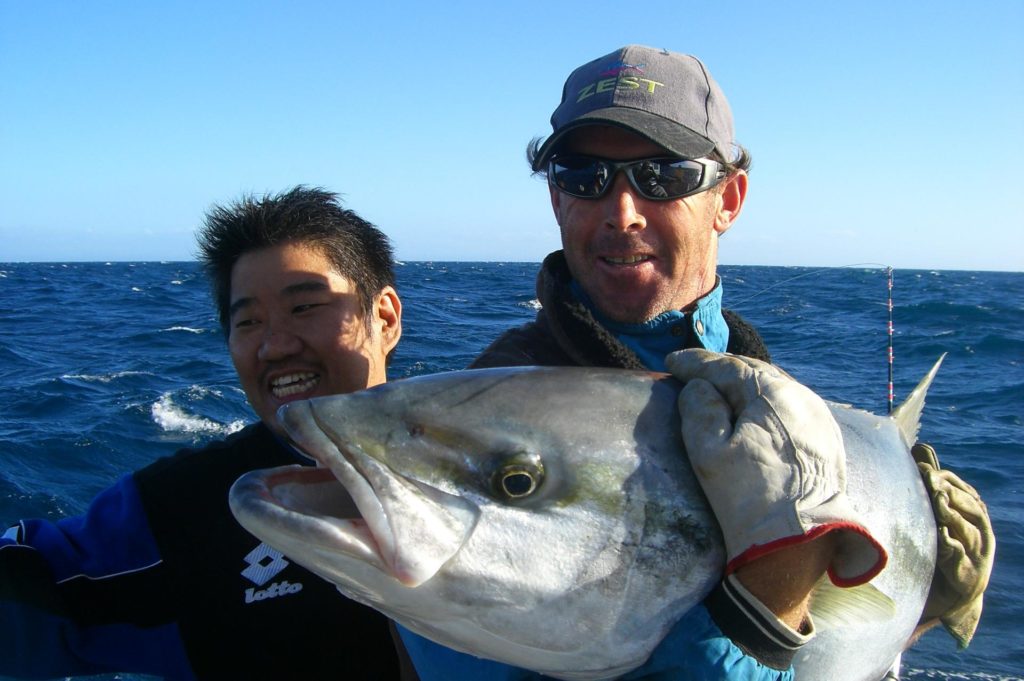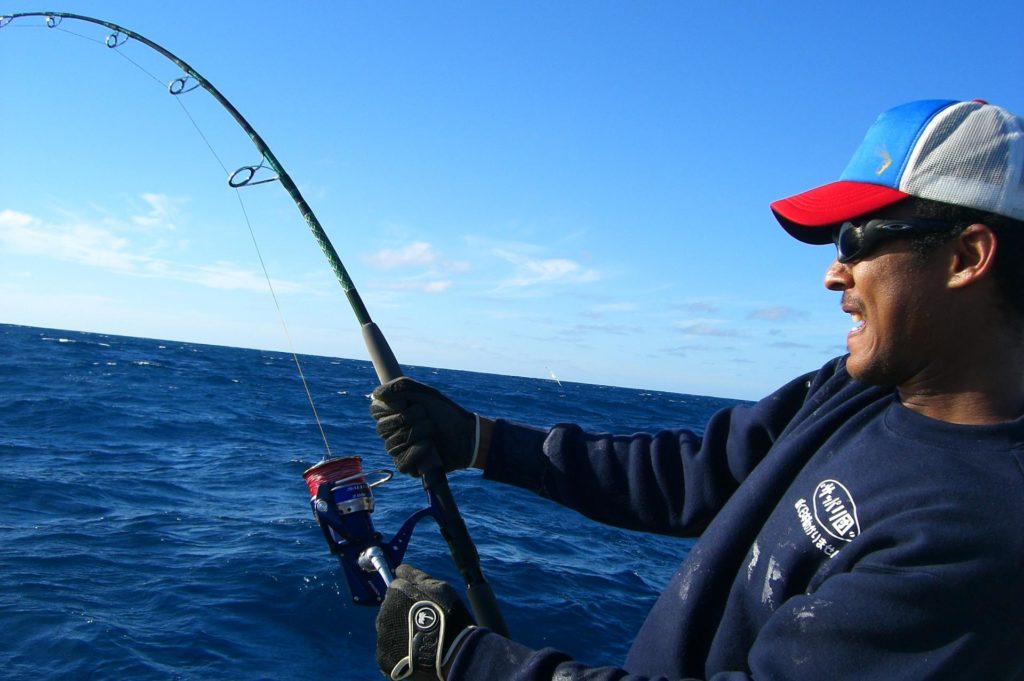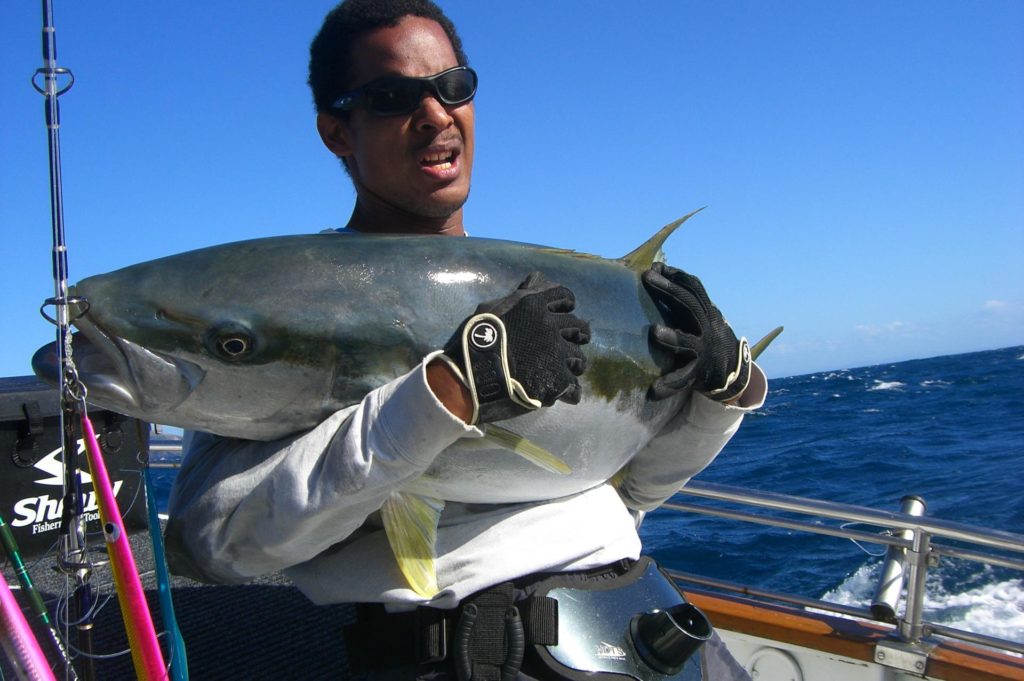The brilliant green coastline along the Bay of Plenty seems to stretch on forever. Void of man-made objects other than the road in front of us, it’s a stark contrast to the landscape where our journey started. The road beckoned further exploration, but this group of Tokyo anglers was headed to a stretch of open ocean few get a chance to experience.

Sport fishing has taught me never to get too wrapped up in akagore (anticipation). So many variables affect how well the fish will bite, that I’ve learned to take a day on the water as it comes and savor the rush that comes with unexpected action which fuels my angling passion.
So as the Enchanter, my group’s fishing boat, pulled away from the port of Whakatane, I reminded myself of the disappointment that often accompanies anglers’ akogare. A few minutes out, I was suddenly overcome with an almost dreadful realization that I had finally made it to New Zealand for what I was certain would be some of the wildest and toughest offshore game angling I’d ever experience.
We were after yellowtail kingfish (seriola lalandi), found throughout the Pacific including Japan, where they are by far the most popular offshore lure fishing quarry. Known to strike and fight hard like few other game fish, a large kingfish on the line will pull like a freight train headed straight down.
The numbers of these beasts topping 30 kilos caught in the waters off New Zealand exceed any place on earth. We were headed to the Shangri-La of kingfish fishing but expected to also land some “wreck fish” such as hapuka (polyprion oxygeneios) and sea bass (polyprion americanus), which grow much bigger.
Ten hours after we launched, I stepped out to the bow and gazed at the sunrise over the Ranfurly Bank – an undersea mountain rising from a depth of 3,000 to just 40 meters at its shallowest point.
After a greasy Kiwi breakfast, we started rigging our jigging rods while the captain searched for schools to target on his fish finder. A few minutes later I was repeatedly dropping my heavy 650-gram lure to the 80-meter sea floor and working it back up to 60 meters.
Jigging is basically jerking a fishing rod so the heavy metal lure, called a jig, darts upward and flutters downward, creating a silhouette similar to an injured or fleeing bait fish. It’s a rhythmic technique that takes a little time to learn but entices some killer strikes. It can also be physically demanding which I quickly learned after dropping my jig about 10 times.
My right shoulder was telling me I should have lifted a few weights before leaving Narita. To my left, Kaname Okubo, my fishing club buddy old enough to be my dad, was banging away effortlessly. But before I had time to be discouraged, I was nearly doubled over into the water by my first Kingfish of the trip.

After yelling out a few expletives and getting my balance, I leaned back, popped my rod butt into my fighting belt and held on for life as the 20-kilogram monster proceeded to try to make a run for the sea floor. Fortunately, my custom-built rod was giving me all the leverage I needed, and I stopped the fish dead in its tracks. About three minutes later I was all smiles, posing with my trophy before releasing it. Not to be outdone, Okubo was soon lifting his first king to the boat when Lance, our captain, signaled the rest of us to bring in our lines. Although we had caught two big fish, he wasn’t satisfied with the conditions, so we headed for the 40-meter “peak” of Ranfurly.
Upon arrival we were amazed to see a massive school of kings on the surface about 50 meters off the bow moving toward us. There had to have been more than a hundred fish swimming about, completely unconcerned with our presence.

“Bloody rats,” Lance said, referring to the school averaging five to seven kilos each, “These guys aren’t worth the…” Before he could finish his sentence, three of us had switched to our top water casting rods and sent our plugs out to the middle of the school. What ensued was almost comical, as the fish crashed over and into each other trying to bite our lures.
I looked port and starboard and saw dozens more fish streaming toward the boat in clusters from all directions. From an angler’s perspective, it was akin to a biblical event. As far as we knew, we were the first group from Japan that knew how to catch kingfish with top water tackle, although it would only be newsworthy if we managed to pull up a much larger fish.
A bit later, we drifted on a 120-meter sea floor where we finally managed to get into one of those legendary tug-o-war sessions with a school of big Kiwi kings found 40 meters from the bottom.
At one point, all six of us had a fish on, causing Lance and his first mate Phil to run back and forth for about 20 minutes, trying to keep lines from tangling, pulling fish after fish on deck, snapping pictures and releasing the monsters.
After a while, I dropped my jig all the way to the bottom to see if anything bigger was lurking below. We were drifting at close to four knots, but I could keep my jig moving just five meters off the sea floor, pulling at it sharply and reeling slowly to get the most flutter out of it. After the fifth or sixth drop, I pulled up but couldn’t move my rod.
“Damn, I’ve got the bottom,” I thought aloud. “Hapuka,” Okubo and Lance said in unison. “Huh?” Then I felt my gear get 10 times heavier. I felt violent bursts of head shaking as I got the fish to about 20 meters from the surface, then my tackle got lighter as if the fish suddenly lost half its weight. The poor thing had embolized. I kept pressure on, but the fish basically floated the rest of the way to the surface with its swim bladder hanging out of his mouth.

My hapuka was the first casualty but would be great eating for dinner. That evening multiple weather reports were saying we’d get 25-knot winds the next day. We’d have to leave the Ranfurly Bank and motor 10 hours out to a new point that offered protection from the wind and waves. We arrived in the late afternoon at a majestic-looking caldera volcano known as White Island.
We had a bit of time to fish before dinner so drifted to the north side of the island a few times, weary from being smacked around in the waves on the ride over. There kingfish were as plentiful as at Ranfurly but not as big. Within an hour, we waved the white flag to anchor up for the night. On Day 3, we motored out from White Island for more jigging and casting near some exposed rocks. I now had my sea legs and felt confident I could handle anything. An early massive strike told me otherwise. This king pulled drag like none before. For about five minutes, I couldn’t wind or pull up. I was sure he would bust off on the bottom.
Yoichi Mogi, our trip organizer, took out his video camera and filmed me screaming and moaning as I held on, waiting for my catch to tire. Eventually, I got the fish’s head turned toward me and slowly brought him up. Once I had the 30+ kilogram kingfish on deck, I could barely hold him for a picture.
Soon after, Mogi tied on a huge 160-gram top water plug and lobbed it out towards the rocks. His rod suddenly bent violently and his drag started screaming. I t could’ve happened to anyone, but there’s something special about a guy who can boat a 47-kilo king in less than four minutes. Everyone was dumbfounded. Lance was so excited, he called several radio stations to report the catch and, by lunch time, the news was all over sport fishing blogs and forums.
Later that afternoon, I hooked another fish weighing nearly 30 kilos, which again kicked the crap out of me. Okubo and the others also were slammed by monsters. It was a day of personal records for us all. At this point, I was running more on adrenaline than actual energy.
I let out another cast before I had time to consider taking a break, then five or six Krakensized beasts smashed my plug at the surface. One inhaled it, but the hook didn’t set before it spit it out. I stopped reeling in my line and just stood there, suddenly reduced to a feeble state by the mere site of the fish I nearly had to fight. My arm muscles were tightening and my hands were throbbing. For me the trip was over.
We pulled back in to Whakatane early in the afternoon the next day just as another group of anglers was waiting to get on board for their own fishing adventure. They were giddy with excitement when they realized how well we had done.
Tired as I was, I spent the rest of my time on the ground in New Zealand trying to figure out how I could budget another trip as soon as possible. The thought of a move to New Zealand with my girlfriend even crossed my mind. I realize, however, living in Kanto is what makes me appreciate the sea so much. When I’m roughed up from the waves, shattered and crawling back to urbanity, it is clear to me why I’m alive. It’s for those times a single thought continuously loops in my mind: “God, I love fishing.”





